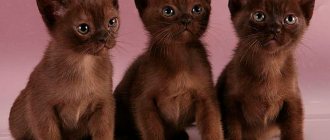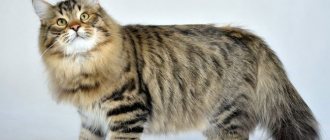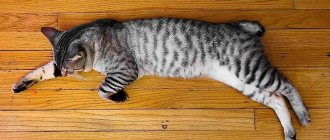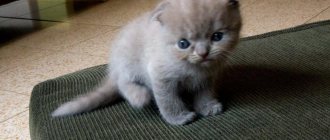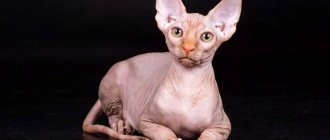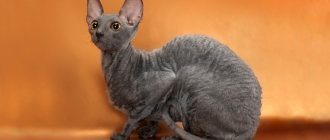- Pets
- >>
- Cat breeds
* Here is a photo of a typical representative of the Burmese cat breed . You can send us photos of your animals by email, and we will post them on the website. Don't forget to send your pet's name.
Other breed names:
Sacred Burma
Video
* We invite you to watch a video about the Burmese cat . In fact, in front of you is a playlist in which you can select and watch any of 20 videos about a given cat breed by simply clicking on the button in the upper right corner of the window. In addition, the material contains quite a lot of photos. By looking at them you can find out what a Burmese cat looks like.
In this article:
|
Diseases
Burma's health is good: the immune system successfully resists most dangerous infections, therefore, if you follow the vaccination schedule, you will not encounter diseases such as panleukopenia, rabies, rhinotracheitis, calcivirosis and the like.
But genetic problems - alas! - happen often. This is due to the limited gene pool.
- Hypertrophy (hypertrophic cardiomyopathy) – the ventricle of the heart decreases, which leads to a decrease in the volume of blood pumped, the risk of heart failure and the formation of blood clots. Symptoms: decreased activity and body temperature, shortness of breath, asthma attacks, paralysis. Complex treatment is required, in some cases surgery.
- Corneal dermoid is a congenital benign formation in the eye area. Treatment is surgical.
- Body tremors - appears in kittens. The reasons can be different: relaxation during sleep, the kitten is cold, scared or very happy, in some cases it occurs after the animal has had a hearty lunch. But if the trembling does not go away, do not put off visiting the veterinarian! This may be a symptom of cystitis, rhinotracheitis or herpes virus infection.
- An increased concentration of creatinine in the blood indicates kidney problems.
Spongiform degeneration, a lesion of the nervous system, stands apart. The cat begins to worry, it salivates, there is loss of orientation, and muscle tremors. Infection occurs through food. Unfortunately, there are no means of prevention at the moment, with the exception of strict control over food and processing of meat products.
Expert opinion
Dusheba Vera Ivanovna
In 2010, she graduated from the Moscow State Academy of Veterinary Medicine named after K.I. Scriabin with honors, specializing in veterinary medicine. I regularly attend veterinary conferences, congresses, and webinars.
Veterinarians do not recommend spaying or neutering Burmese cats (unlike many others). Both the first and second operations are not simple, and they should be resorted to only in cases where the animals really suffer during periods of hormonal surges. For the Burmese, this time passes completely unnoticed and does not affect health or behavior, which means there is no need to resort to extreme measures.
History of the origin of Burmese cats
The origin of this breed is surrounded by beautiful myths and legends of ancient Burma, where these cats lived in temples for many years. An ancient legend says that Burmese cats used to have snow-white fur without any dark spots or markings. One day, robbers broke into the ancient temple in which the sacred statue of the goddess was kept. They wanted to destroy the temple and steal a valuable statue of the goddess.
The abbot of the temple, who was protecting the statue of the goddess, was killed, and his pure holy soul moved into his beloved cat named Singh. The cat, according to legend, stood near the head of his dead owner, the color of his fur changed, and his eyes became blue. The cat screamed shrilly, and the other monks were able to find the strength to drive away the robbers. The enemies failed and fled, and all the cats that lived at this temple received sky-blue eyes, the same as those of the statue of the goddess, and a beautiful golden color.
Interesting fact: In the first decade of the 20th century, cats of this breed were imported to France, where selection work to breed the breed began. However, this breed was almost completely exterminated during the harsh times of the world wars. There were very few cats; some animals died in houses from bombing and shelling, others from hunger.
To prevent the breed from disappearing altogether, Burmese cats began to be crossed with Persian and Siamese breeds. In 1925, this breed was given an official name, and the first exhibition of Burmese cats took place in Italy back in 1926. In 1966, the breed found recognition in Britain, and later in the USA. Today, this cat breed is considered very popular all over the world. These cats with beautiful long hair, sapphire-colored eyes and point coloring are bred all over the world.
Burmese cat - description of the breed
Burmese cats are medium-sized cats with a strong body with strong and well-developed muscles. The height at the withers is about 30 cm, the weight of cats is about 4 kg, males are 5-6 kg. The body is neatly built, the shoulders and hips are approximately the same size, the bones are large and strong. Sexual dimorphism favors males, which means that cats are much larger than cats, and cats have brighter fur colors.
The limbs are small, but strong and muscular, the paws are round. The paw pads are mostly pink, although they can also be colored like the points. Burmese cats have very beautiful, long and fluffy tails, and it is for their beautiful tail and fluffy fur that breeders value them so much.
The head of cats of this breed is large and round. The ears are small and erect. The tips of the ears are slightly rounded. Small hair tassels on the ears are allowed. The eyes are large, round, sapphire blue. The mustache is long. The muzzle, tips of the paw ears and tail are painted in darker colors.
Interesting fact: Burmese cats have beautiful, soft, long hair. Their wool is silky, does not tangle, and has no undercoat. On the cat's back and chest the hairs are even, but in the belly area the hair may be slightly curly. On the chest there is a beautiful collar of long and silky wool.
The gait of Burmese cats is soft and smooth. Cats have innate royal manners; they are neat, calm and majestic. The average life expectancy of Burmese cats is 12-15 years.
Burmese kittens are born almost white, but over time, markings of darker tones appear on the face, paws and tail. In adult cats, the nose and muzzle, ears, tail and paws are painted in dark colors.
Standards
The appearance of the Burmese is immediately remembered - its look is so expressive and its color is amazing. Individuals are of average size, males weigh no more than 6 kg, females - no more than 3. In color they resemble Siamese cats, but have a more docile character and graceful physique.
| Standard | Description |
| Head | Round, wide, with expressive features. The forehead is convex, but moderately; the skull is longer than wide. The muzzle is developed, rounded and wide. The cheeks are plump and rounded. Cheekbones stick out. The chin is powerful and strong. The nose is “Roman”, not long, the transition may or may not be present. The ears are slightly tilted forward, located on the sides of the skull, and are small. Their tips are rounded. The inside of the auricle is moderately pubescent. The neck can be either short or long, but is always muscular. |
| Eyes | Expressive, large, round. Set wide apart. The iris can be colored in different shades of blue, from light to dark. The latter, by the way, are valued higher. |
| Torso | Elongated, squat, with developed muscles. The bones are strong. |
| Paws | Muscular, medium length, rounded, large paws. Tufts of fur are visible between the toes. The pads can be brown, brown or pink. |
| Tail | Medium length, dark, with a fluffy tip. A funny feature: the Burmese cat wears it raised when walking. |
The defects of the breed are the presence of colored inclusions on the white areas (this results in disqualification); squint, silvery shine in the eyes (or one), bends in the tail, different eye color.
Popular colors of Burmese cats
Burmese cats have a beautiful point color.
There are quite a lot of different colors, but here are the most popular ones:
- SBI n - chestnut or chocolate point. This color is considered the brightest and most contrasting. The points are bright brown, evenly and completely colored. An even diamond-shaped mask should stand out on the cat’s face. There should be no light areas on the points; white spots on the points are not allowed at all. At the age of 2.5-3 years, the fur on the back and sides darkens slightly; in rare cases, the animal’s abdomen darkens;
- SBI-21 this color is characterized by dark brown striped points. The color is very similar to the previous one, but the points have dark stripes;
- SBI a - blue or silver point. The general color of the animal is white, and the points are cold silvery tones. The points must have an even color. On the face there is a diamond-shaped mask of gray color, the ears are gray. On points, light colors are undesirable, but acceptable. By the age of 2.5-3 years, the back and sides of the animal are covered with a so-called silvery cloak. In rare cases, the pet’s belly may also darken;
- SBI a 21 - striped silver point. The color is the same as the previous one, but the points are striped;
- SBI b - classic chocolate point. This color is not as bright and contrasting as the previous ones. The tail and dark points should be well and evenly colored. It happens that the points are very light; they can be the color of milk chocolate. The mask on the muzzle is not wide. The diamond shape of the mask ends behind the outer corners of the eyes, and the forehead is covered by the mask approximately to the middle. Light areas on points are undesirable; the body body does not darken with age;
- SBI b 21 - the same chocolate point only with stripes. The classic color is white combined with light red striped points. Some have a red color on the nose, palate and paw pads. Over the years, the animal's body does not darken;
- SBI c - lilac point. Pearl-colored points. The mask on the face, like that of the blue point, is not wide, the points are evenly colored in pearlescent color. The sides of this color never darken;
- SBI c 21 - lilac point with stripes.
Character and habits of Burmese cats
Sacred Burma is a true personification of wisdom and tranquility. These animals hate noise and fuss. Instead of active games, Burmese cats like to sit and calmly watch what is happening around them. They are very calm, it is very difficult to anger a Burmese cat, and even if this can be done, it will not hiss or rush at the offender, but will simply get up and calmly leave with royal majesty, not wanting to get involved in a conflict.
Interesting fact: Burmese cats are not only pets, but also true friends. They are extremely loyal to their owner, very sociable, but at the same time they do not tolerate bad treatment. Cats of this breed are distinguished by high intelligence and innate good manners. They are always majestic and calm, they understand well what a person says, and quickly get used to the tray, scratching post and sleeping place.
Animals can treat children differently depending on the character of a particular individual and mood. These cats are not very playful, but can be quite tolerant of children. Relations with other animals are calm. Burmese get along quite well with dogs, provided that the dog does not offend the cat. Rodents and birds can become prey for a cat, so animals should not be kept in the same room.
The main problems usually arise with unsterilized cats and female cats. At a time when the cat’s nature demands its way, the animal can become aggressive, meow and especially fiercely guard its territory. Males mark their territory. Castrated and sterilized cats always behave calmly and decently. For older people, Burmese will be excellent companions who will not let you get bored.
Burma and children
Burmese kittens get along well with children, especially if the babies are raised together from diapers. You can leave your pet with your child without fear, knowing that it will not bite or release its claws.
Usually Burmese people patiently endure the not very skillful caresses of babies. First, you should still talk to the child, explaining that the cat is a living creature and you need to be careful with it.
Older children who love and know how to handle animals tend to find contact with Sacred Burma. Children and animals often become best friends and enjoy playing together.
Interesting facts about Burmese cats
Sacred Birman kittens are born with soft, snow-white fur, which gradually darkens with age. The coloring of the Burmese cat is a type of albinism. Wool is dyed dark in so-called “cold places” where blood circulation is poorer. You should also remember that if a cat is exposed to the cold for a long time, its fur may darken prematurely.
A unique fertility record was set by the Burmese cat. A mother named Antigion gave birth to 19 kittens in one litter. The Birsk breed includes a cat that has set a record for longevity. On average, cats live from 12 to 15 years, but the Catalina cat from Australia was able to live as much as 35 years. This cat is listed in the Guinness Book of Records as the oldest cat in the world.
Burmese kittens are born with disproportionately large ears, but over time the kitten's head and body grow into correct proportions. Shorthaired Birmas are very rare, but they do exist. The main characteristics of the shorthaired Burmese are white socks on the paws, short hair and a small undercoat. The cat's head is large and round, its eyes are sky blue.
Seals of this breed are excellent hunters; they will happily stretch their bones while hunting in the garden. Seals like to hunt more because of sporting interest; domestic cats are unlikely to eat their prey, but they can bring their trophy to the owner in order to be praised.
Cats of this breed are not adapted to living in cold climates outside homes. These cats are very heat-loving, they quickly catch a cold outside in bad weather, and in houses these animals find the warmest place to rest. By the way, only Burmese people like to sleep under a blanket at night.
Friendliness
Sacred Burma is genetically very attached to humans. Communicative qualities, such as friendliness, sociability, and trustfulness are represented in these cats to the maximum extent, and these qualities are manifested to a greater extent in cats than in cats.
Sacred Burma is recommended for large families with children and elderly relatives. In this case, it will be easier to arrange so that one of the household members is always at home and can communicate with the pet.
Burmese kittens very quickly socialize and adapt to the conditions of the home where they will live. They love to be in the thick of things and take part in the daily affairs of the family. Another striking feature of Sacred Burma is its friendliness towards strangers. The Burmese cat will not hide from guests, but, on the contrary, will come out to meet you with curiosity.
Pros and cons of Burmese cats
Advantages of the Burmese breed:
- Burmese cats are very beautiful. The aristocratic appearance speaks of the elitism of the breed. This breed includes the beauty of the Persian, Siamese and Burmese breeds. The cats have beautiful fluffy point-colored fur, blue eyes and a huge fluffy tail;
- Burmese are able to understand the feelings of the owner and adapt to the mood. If the owner is sad, the cat will always come to the rescue and try to support the owner by gently purring and trying to attract attention;
- Calm and flexible character. It is very difficult to anger a cat of this breed, and even if this happens, the cat will not take revenge or hiss, most likely, he will simply leave without wanting to enter into a conflict;
- Burmese have excellent health; no genetic diseases have been identified in cats of this breed, and with good care, the cat can live a long and happy life;
- Cats of this breed do not require complex care despite their rather long hair. The animal's fur has an even, smooth structure and does not tangle or mat;
Disadvantages of the breed:
- Cats of this breed should not be allowed outside during the cold season as the animals are not adapted to cold climate conditions. Burms get cold quickly, and their coat can darken prematurely in the cold;
- Burms do not like intrusive affection; if the cat is in a bad mood, it may avoid people;
- Pets of this breed are not suitable for families with babies and small children. These animals do not like to be cuddled or carried. They don’t like noise and fuss, and although Burma won’t hurt a child, they won’t play for hours and tolerate bad treatment;
- Unneutered cats mark their territory, and unsterilized cats can become aggressive and meow at night;
- Price. Kittens of the Burmese breed cost from 40 to 100 thousand rubles, depending on the pedigree and nursery, which is not cheap at all.
Breeding Burmese cats
Breeding the Burmese cat breed is not an easy and extremely important task, because the health and vitality of the offspring depends on the correctly selected parents and their health.
Therefore, when breeding cats of this breed, you must adhere to the following rules:
- Males and female cats with any congenital abnormalities cannot be used for breeding;
- Cats of any breed used for breeding must have a mustache;
- Breeding cats must have a certificate that confirms the male health of the stud cat;
- A breeding cat can be used for mating if she has had no more than 3 births in the last 2 years;
- A cat that cannot give birth naturally or has previously had a caesarean section cannot be used for breeding;
- There should be a break of 3 weeks between matings with different cats;
- All animals used for breeding must be microchipped;
- Cats with an umbilical hernia, deafness and other diseases are not allowed for mating;
- Mating is carried out on the territory of the male. For mating, a separate room should be allocated where the animals can quietly retire. Before mating, animals must undergo a medical examination;
- During mating, the owners must provide the female with the usual food and tray so that the animal feels good;
- Childbirth must be supervised;
- To register kittens, the owner must provide the kittens themselves, a mating certificate filled out on the club's letterhead with the signatures of the owners of both parties. The direction given by the instructor for this mating. The animal's name is included in documents in any language at the request of the owner;
- Animals without a pedigree cannot participate in mating; they must be sterilized;
- Kittens under 12 weeks cannot be separated from their mother. Animals can be transferred to another home after the kittens are weaned from the mother's breast and receive all necessary vaccinations.
Attitude towards other animals
Sacred Burma, as a rule, finds a common language with other pets sharing the same territory with her (although at first, manifestations of jealousy are not excluded). Smaller animals should still be isolated, since the hunting instinct of the Burmese is quite developed.
To eliminate manifestations of jealousy, the owner must develop the correct tactics of behavior: the animals should be given equal attention, without depriving anyone. Conflicts are excluded if animals grow up together, getting used to the house, owners, and surroundings.
The issue of dominance may arise if animals appeared in the house as adults (especially if they are unsterilized). Castrated and sterilized Burmese, as a rule, do not display jealousy or aggression.
Caring for Burmese cats
Cats of the Sacred Burmese breed are unpretentious and do not need any special tricks. Caring for them is quite simple and anyone can handle this task. Before bringing the cat into the apartment, the room must be prepared. You need to go through your home and remove all protruding wires and cables. Put away expensive porcelain, gadgets and other items that your cat might accidentally break.
Also, the room needs to be made safe, all cracks where the cat could get stuck should be closed. Tightly cover toxic substances that could poison the animal. In addition, the animal needs to have its own personal space. The cat needs to buy a soft and comfortable bed, a tray and a place for food, equipped with large bowls. The cat will also need a scratching post and toys. For trips to the veterinarian, it is worth purchasing a carrier.
In general, caring for a cat is not difficult. You need to bathe your cat once every 3-4 months with a special shampoo. The eyes and ears of the animal are examined and carefully wiped with a cotton pad. Nails are trimmed with special scissors every three weeks. Despite the long hair, it does not cause much trouble. Once a week, the animal must be combed with a special soft comb to remove dead hair.
Fun fact: Raising Burmese cats is usually easy. Cats feel their owner well and quickly understand what is required of them. The main thing is not to miss the moment and explain to the cat the rules of behavior in your home from childhood. Animals should not be allowed to scratch furniture or climb onto tables. A cat's litter box training is usually done by a breeder.
Burms don't tolerate shouting and they especially don't like being shouted at, so try not to do this. When committing negative actions, switch the animal’s attention to toys. Sacred Burmas do not tolerate cold; there should be no drafts in the room where the animal is kept.
How to cope with loneliness
The Sacred Burma is a very social animal and does not tolerate loneliness well. Past life experience is of great importance to her. A kitten raised in a large family will constantly need affection and extra attention.
It is very good if one of the household members is always at home. In this case, the pet will not be deprived of attention. If adults and children go about their business every morning, leaving the Burmese alone to while away the time in the apartment, he may feel lonely. In the evening, you need to reward the sufferer by giving him maximum attention and participation.
It is highly not recommended to leave Sacred Burma alone for a long time. Being isolated and separated from its beloved owner, the pet will experience severe psychological discomfort, which can develop into depression.
Diet of Burmese cats
Burmese cats are good judges of what they eat. They are able to control themselves and not overeat. You can create your pet's diet using only dry food. Dry food is completely balanced and contains all the necessary supplies of vitamins and microelements.
Sometimes you can pamper your cat with canned food. If you want to create a cat’s diet from natural products, do not forget that it must be balanced.
The daily diet should include:
- Thermally processed meat (chicken, turkey, rabbit, lean beef);
- Thermally processed fish of low-fat varieties. Under no circumstances should you give your cat smoked or salted fish;
- Liver, lung, spleen;
- Cereals (buckwheat, pearl barley, oatmeal);
- Dairy products (kefir, cottage cheese, sour cream);
- Boiled vegetables.
Chicken or quail eggs can be given in small quantities. You should not feed the animal from your table. Pet food must be prepared separately without adding salt or spices. Pregnant and weakened cats, as prescribed by a veterinarian, are given vitamin complexes that are purchased at veterinary stores.
In addition to food, cats should have clean water in a separate clean bowl. Always make sure that the dishes from which the cat eats are clean; any remaining food must be removed. It is better to leave dry food in reserve.
Price
You should only buy a Burmese cat from a trusted breeder. The peculiarity is that at an early age (up to six months) you will not find clear indicators of the breed in the animal. An unscrupulous seller may sell a kitten that turns out to be a mixed breed or even outbred.
If you plan to take part in exhibitions or engage in breeding with your cat, you should take a kitten that is already 6 months old. At this stage, it is possible to largely eliminate the shortcomings of the breed for which the animal can be disqualified.
The cost of a pet for home keeping is from $550. Kittens purchased for breeding are more expensive - from 800 to 2000 dollars. The cost of show-class animals is at least $2,000.
Diseases and health problems
Despite the long selection history of this breed, these cats are famous for their excellent health. Burmese cats do not have any serious genetic diseases. With age, like cats of any breed, Burmese can develop cardiac diseases, gastrointestinal and kidney diseases. Therefore, once every six months, the pet must be shown to a veterinarian for timely detection and treatment of existing diseases. It is always easier to cure a disease at an early stage than in an advanced stage.
Vaccinations, which must be done on time, will protect your cat from various infectious diseases. Small kittens are vaccinated for the first time at the age of 2-3 months, after which vaccinations are given annually.
Even if the animal does not go outside, vaccinations must be done. Viruses and infections can enter the home on clothes and shoes, and can also be transmitted by parasites. Fleas can enter apartments through ventilation, cracks, from basements and neighboring apartments. Therefore, it is necessary to periodically examine the animal.
Domestic cats and male cats must be spayed and neutered. This is done so that the animal does not suffer. It is better to castrate cats and cats at the age of six months; at this time, animals tolerate this procedure more easily. Neutered cats are prone to obesity, so they need to be fed special food for neutered cats.
Health
This breed has a predisposition to kidney and digestive system diseases. Therefore, it is very important to take care of animal nutrition, since it is this that often affects the occurrence of problems with these organs.
One of the common ailments is cysts, which can be prevented by regularly examining your cat at the veterinarian. Animals are very temperamental and can be too active during the rutting period. Therefore, it is worth considering castration or sterilization. Also, if the female has not mated for several years, problems may begin in the genitourinary system.
